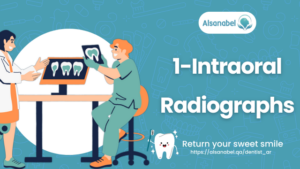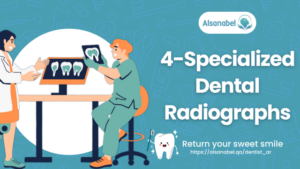When we think of dental care, the image of a dental X-ray often flashes across our minds—a testament to its importance in maintaining oral hygiene. Dental radiographs, or X-rays, are invaluable tools that provide insights hidden from the naked eye, allowing dentists to diagnose and plan treatment with precision. Among these, intraoral X-rays stand as the most common, with subtypes such as the bitewing X-ray providing a window into the concealed spaces between teeth and below the gum line. In this discussion, we will demystify the various types of dental X-rays and illuminate their specific applications, equipping you with the knowledge to better understand this essential aspect of your dental visits.
Table of Contents
Toggle1-Intraoral Radiographs
Intraoral radiographs are X-ray images taken from inside the mouth at best dental clinic in Qatar, providing detailed views of teeth, surrounding bone, and supporting structures. These radiographs are commonly used in dentistry for various diagnostic purposes. There are several types of intraoral radiographs, each offering unique perspectives and benefits:

1)Bitewing Radiographs
Bitewing radiographs are a type of intraoral dental radiographs that provide a detailed view of the crowns of the upper and lower teeth in a single image. Here are some key points about bitewing radiographs:
- Purpose: Primarily used to detect cavities between teeth, assess dental restoration fit, and evaluate bone levels around teeth.
- Technique: Patient bites down on an X-ray film holder, allowing simultaneous imaging of both arches.
- Frequency: Typically taken annually for adults, more frequently for children based on cavity risk.
- Detection of Cavities: Effective in spotting early-stage cavities not visible to the naked eye, aiding in monitoring cavity progression.
- Evaluation of Bone Levels: Provides insight into bone support around teeth, aiding in diagnosing periodontal disease.
- Patient Comfort and Safety: Generally well-tolerated with minimal discomfort and low radiation exposure, further reduced with digital systems.
2)Periapical Radiographs
Periapical radiographs are intraoral X-rays used at our dental clinic to capture detailed images of specific teeth and their surroundings. Key points about them include:
- Purpose: Assess entire tooth length, surrounding bone, and structures for conditions like abscesses, cysts, fractures, and pathology.
- Technique: Film or sensor placed near the tooth, with the X-ray machine outside the mouth.
- Indications: Used for detailed assessment, diagnosing dental pain, decay extent, root health, and treatment planning.
- Diagnostic Value: Reveals internal tooth anatomy, aiding in accurate diagnosis and treatment planning.
- Frequency: Taken as needed based on symptoms, dental history, and treatment requirements.
- Safety and Comfort: Expose patients to low radiation, with modern digital systems reducing exposure. Protective lead aprons minimize radiation to other body parts.
2-Extraoral Radiographs
Extraoral radiographs are X-ray images of the teeth and surrounding structures taken from outside the mouth at best dental clinic in Qatar. It provide a broader view of the oral and maxillofacial region. Here are some key points about it:
1)Panoramic Radiographs
Panoramic radiographs, also known as panoramic dental radiographs or orthopantomograms (OPGs), offer a wide view of the entire oral and maxillofacial region in a single image. Key points include:
- Purpose: Used to assess overall dental and skeletal health, diagnose abnormalities, plan orthodontic treatment, evaluate impacted teeth, and assess dental implant suitability.
- Coverage: Captures images of teeth, jaws, temporomandibular joints (TMJs), maxillary sinuses, and surrounding structures.
- Technique: Patient stands or sits as a specialized X-ray machine rotates around the head, capturing images in a semicircular arc.
- Diagnostic Information: Reveals presence, number, and position of teeth, bone anatomy details, and TMJ assessment.
- Clinical Applications: Widely used in dental practices, oral surgery clinics, and imaging centers for comprehensive examinations, preoperative assessment, and monitoring dental and skeletal changes.
- Safety Considerations: Involves exposure to ionizing radiation, but modern digital techniques minimize doses, and safety measures reduce patient exposure.
2)Cephalometric Projections
Cephalometric projections, also known as lateral cephalograms, are extraoral radiographs used in orthodontics and orthognathic surgery to capture side views of the skull and facial structures at best dental clinic in Qatar. Key points include:
- Purpose: Assess relationships between teeth, jaws, and facial bones, aiding in treatment planning and monitoring progress during orthodontic treatment.
- Coverage: Capture images of the entire head and neck region, focusing on the profile view of the skull from the side.
- Technique: Patient positioned upright with head against a support, while X-ray machine captures a standardized lateral view.
- Diagnostic Information: Provides insight into skeletal relationships, growth patterns, and soft tissue analysis of the face and neck.
- Clinical Applications: Used in orthodontic practices, oral surgery clinics, and maxillofacial imaging centers for diagnosis, treatment planning, and monitoring growth and development.
- Safety Considerations: Involves radiation exposure, but modern digital techniques minimize doses, and safety measures reduce patient exposure.
3-Occlusal Radiographs
Occlusal radiographs, a type of intraoral radiograph, offer a broad view of the entire dental arch and surrounding structures at best dental clinic in Qatar. Key points include:
- Purpose: Visualize large areas of the dental arch, aiding in detecting abnormalities like impacted teeth, cysts, tumors, and jawbone developmental issues.
- Technique: Patient bites down on a specialized film or digital sensor inside the mouth, while the X-ray machine captures the image from outside.
- Coverage: Wide view from the biting surface of teeth to surrounding bone and soft tissues, centered on specific regions of interest or encompassing the entire arch.
- Diagnostic Information: Reveals impacted teeth locations, identifies cysts, tumors, and assesses bone morphology.
- Clinical Applications: Used in dental practices, oral surgery clinics, and imaging centers for diagnosis and treatment planning, especially when a comprehensive view is necessary.
- Safety Considerations: Involves radiation exposure, but modern digital techniques reduce doses, and safety measures minimize patient exposure.
4-Specialized Dental Radiographs
Specialized dental radiographs refer to X-ray images that are used for specific diagnostic purposes in dentistry. These radiographs provide detailed views of specific areas of the oral cavity, teeth, and surrounding structures, allowing dentists at our dental clinic to evaluate various dental conditions accurately. Here are some examples of it:

1)Cone Beam Computed Tomography
Cone Beam Computed Tomography (CBCT) is an advanced dental imaging technique that generates detailed three-dimensional images of teeth, jaws, temporomandibular joints (TMJs), and surrounding structures. Key points about CBCT at best dental clinic in Qatar include:
- Technology: Utilizes a cone-shaped X-ray beam and rotating detector to capture multiple images from various angles, reconstructed by computer software into a 3D representation.
- Detailed Visualization: Provides high-resolution images showing teeth, roots, bone anatomy, nerves, blood vessels, sinus cavities, and soft tissues.
- Diagnostic Applications: Used for implant planning, endodontic assessment, orthodontic analysis, oral surgery planning, and TMJ disorder diagnosis.
- Benefits: Offers accurate 3D representation, reduced radiation exposure compared to conventional CT scans, enhanced diagnostic capabilities, improved treatment planning, and patient outcomes.
- Safety Considerations: Modern CBCT machines minimize radiation doses, with strict protocols ensuring patient safety through appropriate patient selection, scan parameter optimization, and radiation shielding.
2)Sialography
Sialography is a diagnostic imaging method used at our dental clinic to examine the salivary glands by injecting a contrast agent into their ducts and obtaining X-ray images. Here’s how it typically works:
- Purpose: Helps diagnose conditions like salivary gland stones, ductal strictures, tumors, and inflammatory conditions. Used when detailed duct and gland imaging is needed.
- Preparation: Patient’s medical history is reviewed, and fasting may be advised to reduce saliva production.
- Contrast Agent Injection: Iodinated contrast material is injected into the salivary gland duct using a fine needle, often guided by fluoroscopy.
- Fluoroscopy: Allows real-time monitoring of contrast material flow through the ducts.
- Radiographs: Once ducts are adequately filled, conventional X-ray images are taken to visualize gland anatomy and any abnormalities.
- Interpretation: Radiologist analyzes images to identify blockages, strictures, tumors, or other issues.
- Post-procedure Care: Patients may experience temporary discomfort or swelling, requiring post-procedure instructions for pain management and hydration.
Now, we’d love to get your input. Maybe you have a question that’s still lingering, or perhaps you have personal insights or experiences to share regarding dental radiography. Either way, your thoughts are valued, and we encourage you to join the conversation. What facets of dental radiographs do you find most intriguing or essential? Let’s discuss in the comments below.
